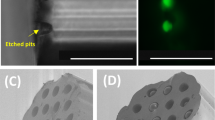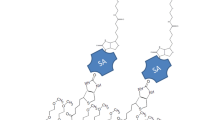Abstract
A LONG-standing goal of clinical medicine has been the continuous, in situ measurement of solute concentrations (such as pH, pCO2and pO2), particularly in blood. Blood monitoring is accomplished at present by analysing discrete samples at a centralized, remote clinical laboratory, causing delays between sampling and analysis. Most multi-analyte sensors developed for 'bedside' in situ monitoring1 consist of several sensors fabricated into a sensor array or bundle2,3. This approach is not ideal where sensor size is an important factor. Here we describe a technique that enables the development of a compact, multi-analyte fibre-optic chemical sensor. The technique is based on localized photopolymerization of appropriate dye indicators on the face of an imaging fibre. The sensing sites fluoresce to a degree controlled by analyte concentration, intensities being monitored simultaneously with an enhanced charge-coupled device (CCD) video camera. We present results from a sensor that contains three individual pH-sensitive areas, and indicate how multi-analyte sensitivity may be achieved.
This is a preview of subscription content, access via your institution
Access options
Subscribe to this journal
Receive 51 print issues and online access
$199.00 per year
only $3.90 per issue
Buy this article
- Purchase on Springer Link
- Instant access to full article PDF
Prices may be subject to local taxes which are calculated during checkout
Similar content being viewed by others
References
Collison, M. E. & Meyerhoff, M. E. Analyt. Chem. 62, 425A3–437A (1990).
Gehrich, J. L. et al. IEEE Trans. on Biomedical Engineering BM-33, 117–132 (1986).
Collison, M. E., Aebli, G. V., Petty, J. & Meyerhoff, M. E. Analyt Chem. 61, 2365–2372 (1989).
Seitz, R. CRC crit. Rev. analyt. Chem. 19, 135–173 (1988).
Wolfbeis, O. S. in Fiber Optic Chemical Sensors and Biosensors. Vols 1 & 2 (CRC Press, Boca Raton, 1991).
Barnard, S. M. & Walt, D. R. Science 251, 927–929 (1991).
Barnard, S. M. & Walt, D. R. Envir. Sci. Technol. 25, 1301–1304 (1991).
Wolfbeis, O. S., Weiss, L. J., Leiner, M. J. P. & Ziegler, W. E. Analyt. chem. 60, 2028–2030 (1988).
Tsumanuma, T., Tanaka, K., Chigira, S., Sanada, K. & Inada, K. Proc. SPIE Optical Fibers in Medicine 906, 92–96 (1988).
Epperson, P. M., Sweedler, J. V., Bilhorn, R. B., Sims, G. R. & Denton, M. B. Analyt. Chem. 60, 327A–335A (1988).
Trauthen, B. Proc. SPIE Optical Fibers in Medicine V 1201, 580–583 (1990).
Munkholm, C., Walt, D. R., Milanovich, F. P. & Klainer, S. M. Analyt. Chem. 58, 1427–1430 (1986).
Munkholm, C., Walt, D. R. & Milanovich, F. P. Talanta 35, 109–112 (1988).
Martin, M. M. & Linqvist, L. J. Luminescence 10, 381–390 (1975).
Author information
Authors and Affiliations
Rights and permissions
About this article
Cite this article
Barnard, S., Walt, D. A fibre-optic chemical sensor with discrete sensing sites. Nature 353, 338–340 (1991). https://doi.org/10.1038/353338a0
Received:
Accepted:
Issue Date:
DOI: https://doi.org/10.1038/353338a0
This article is cited by
-
Luminescence-based methods for sensing and detection of explosives
Analytical and Bioanalytical Chemistry (2008)
-
Fiber-optic Sensor for Continuous Monitoring of Fermentation pH
Nature Biotechnology (1993)
-
Micromachining technology and biomedical engineering
Applied Biochemistry and Biotechnology (1993)
-
Fluorescent optical sensors
Applied Biochemistry and Biotechnology (1993)
-
Clinical evaluation - continuous real-time intra-arterial blood gas monitoring during anesthesia and surgery by fiber optic sensor
International Journal of Clinical Monitoring and Computing (1992)
Comments
By submitting a comment you agree to abide by our Terms and Community Guidelines. If you find something abusive or that does not comply with our terms or guidelines please flag it as inappropriate.



